OLD ENGLISH PHONETICS Accentuation system

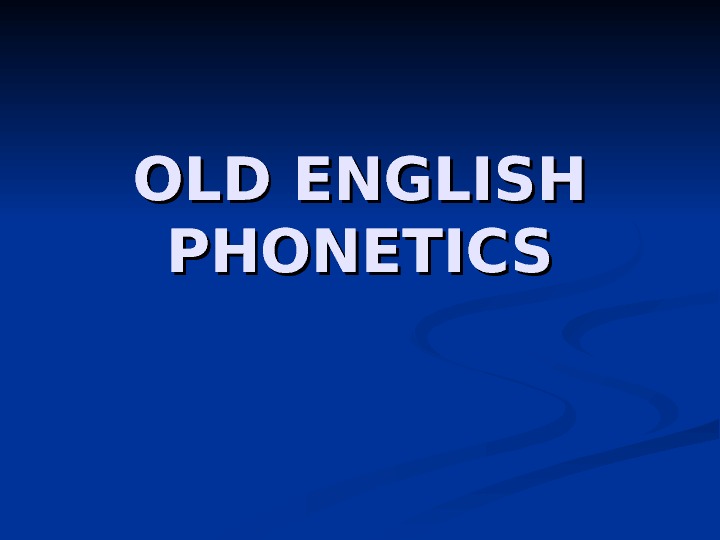
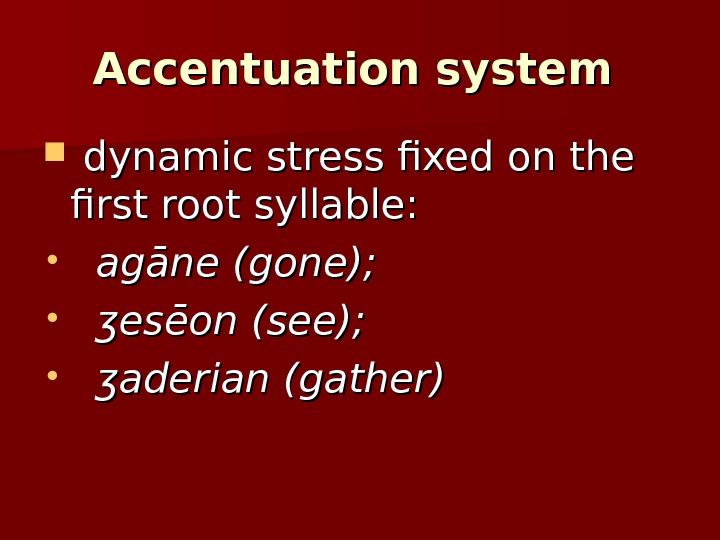
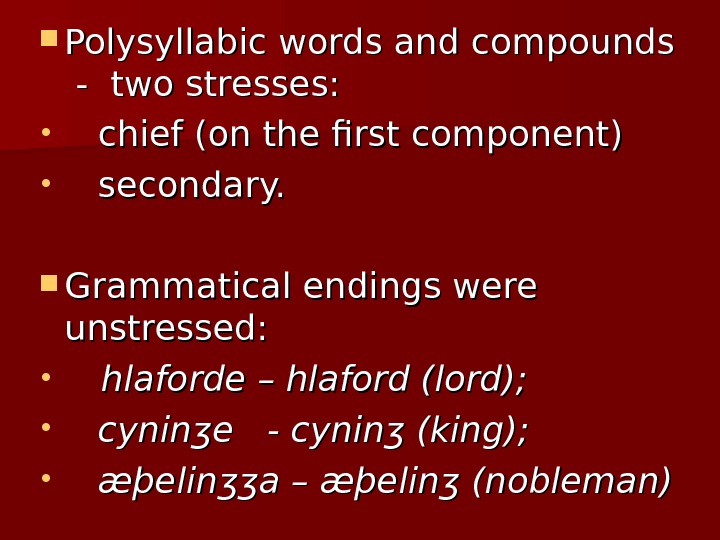
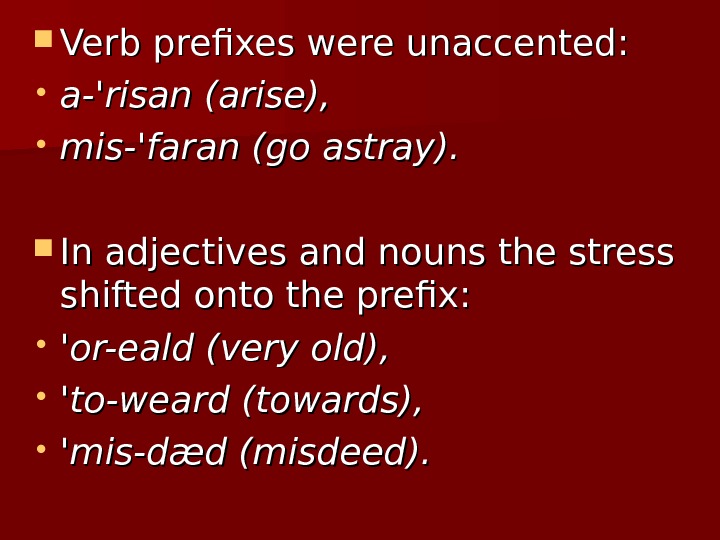
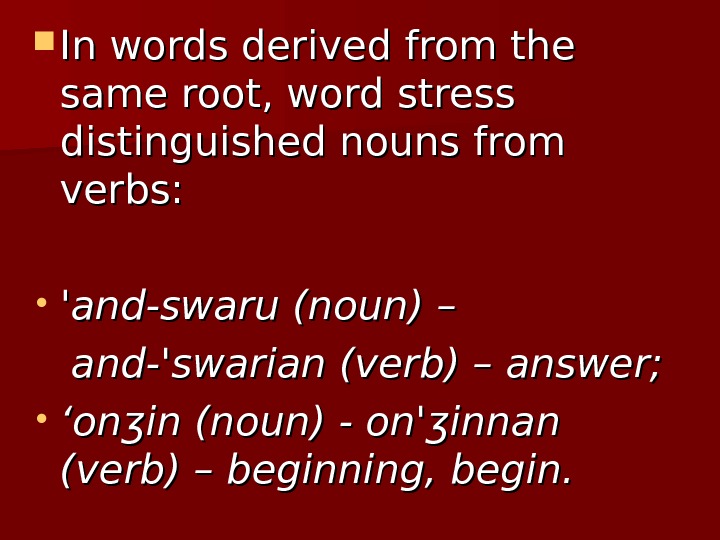
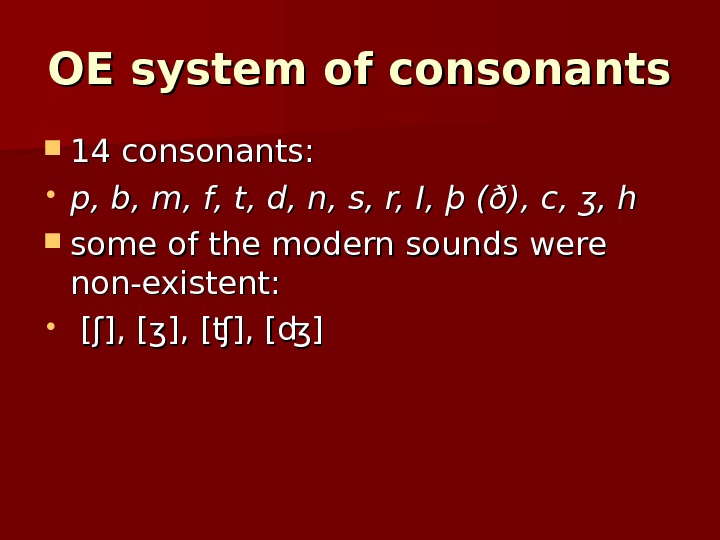
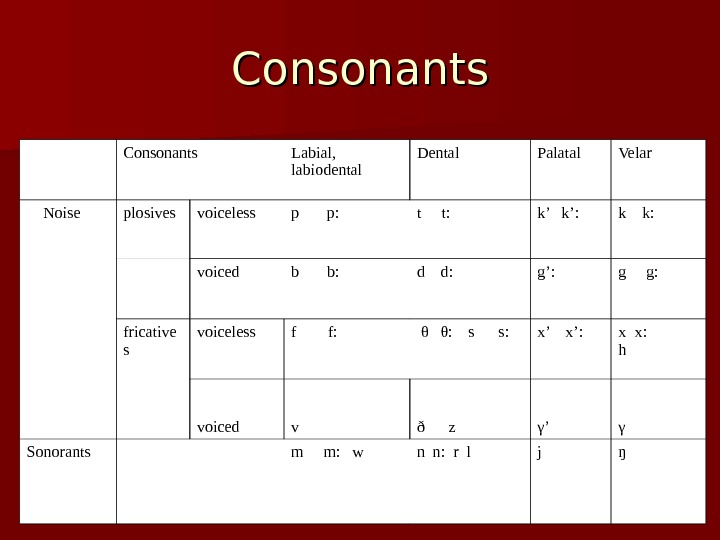
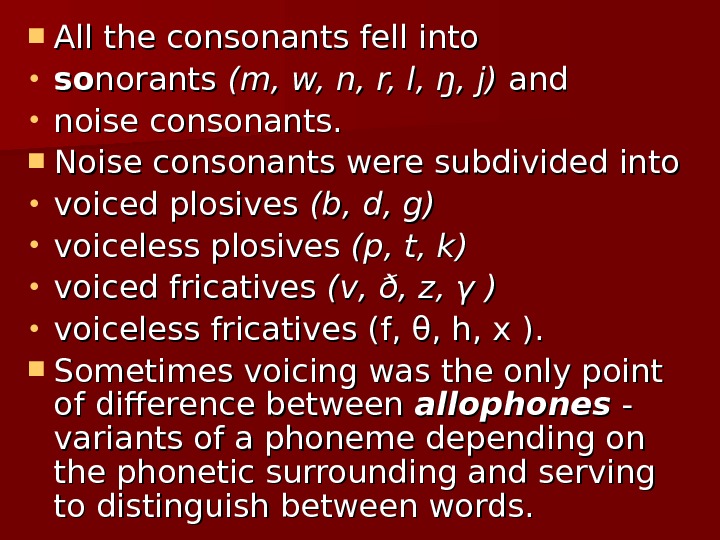
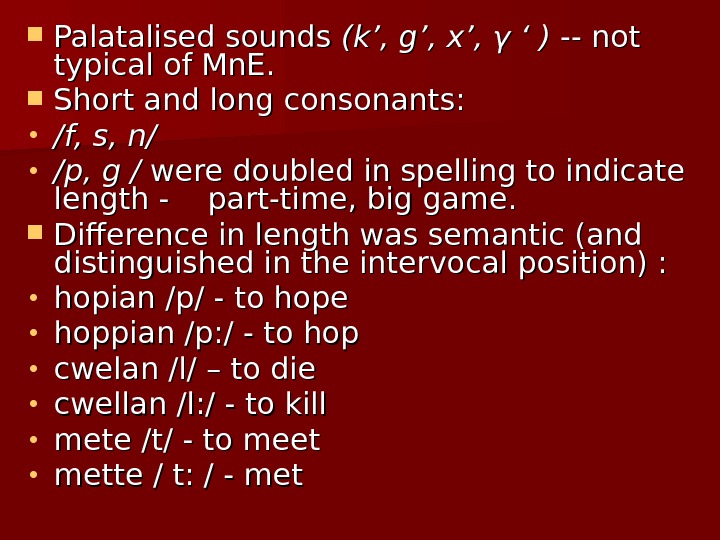
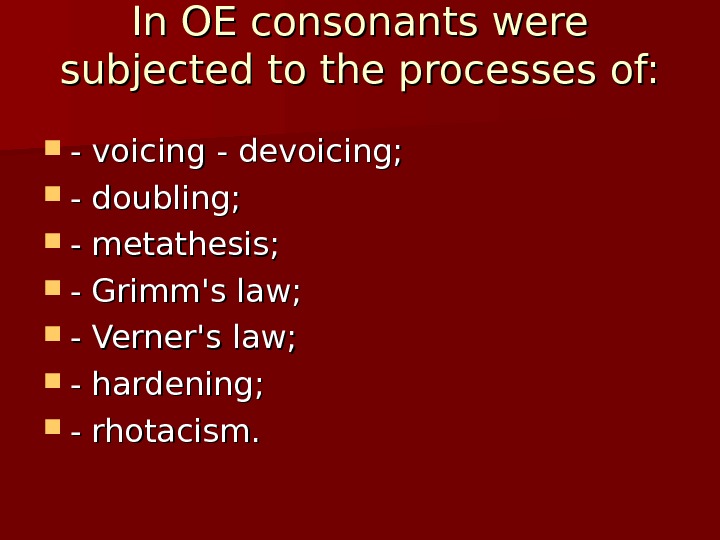
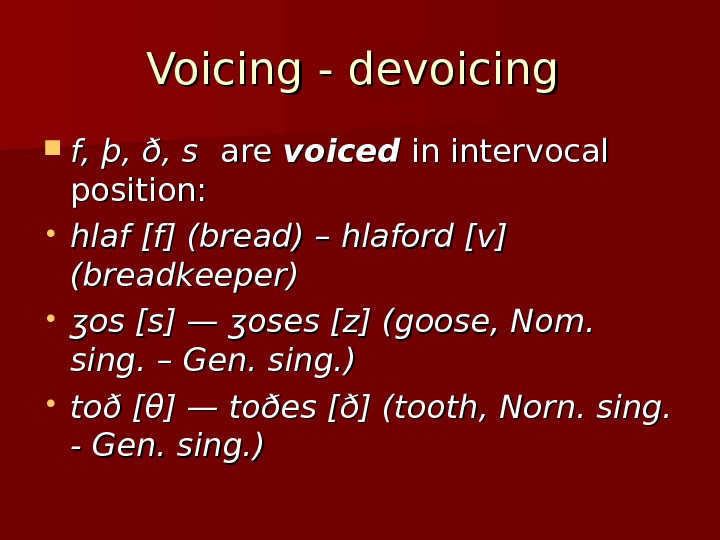
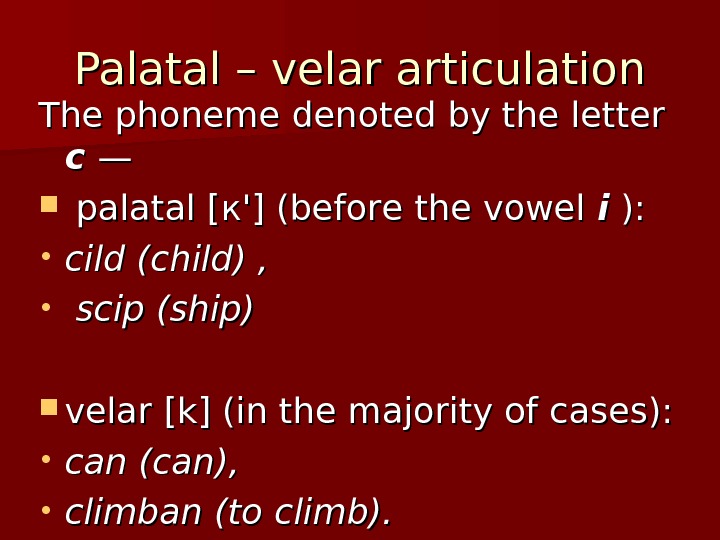
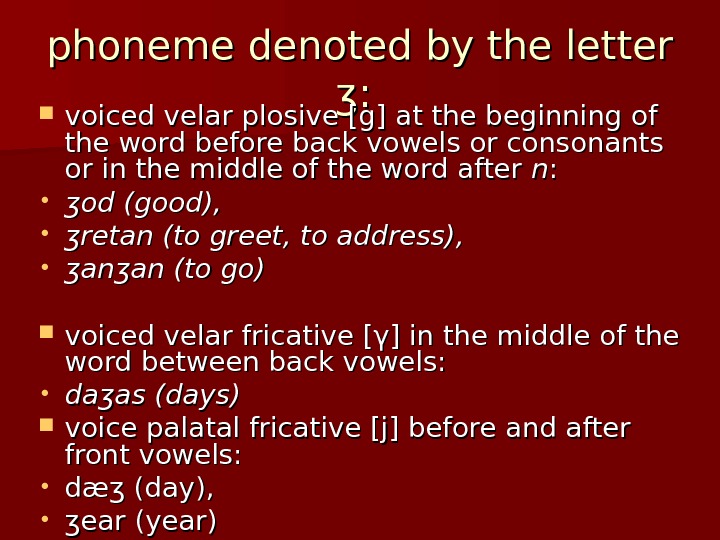
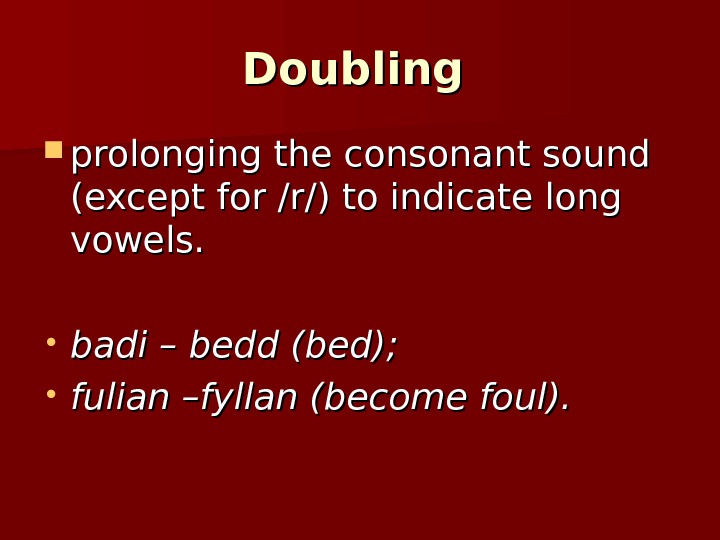

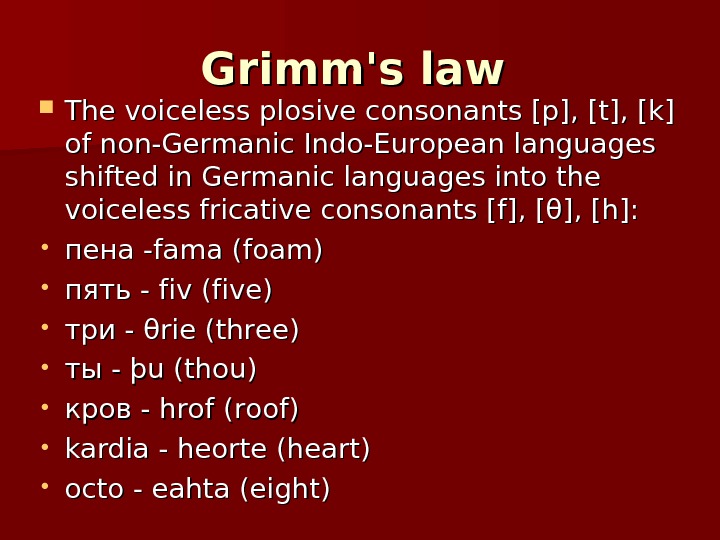
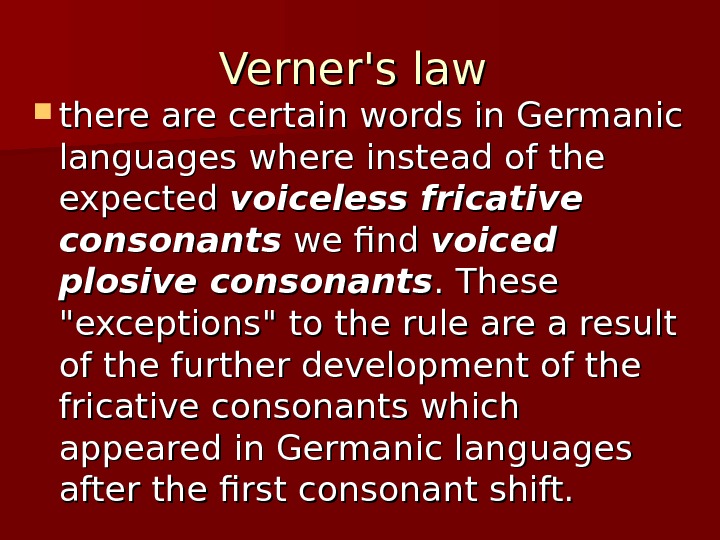
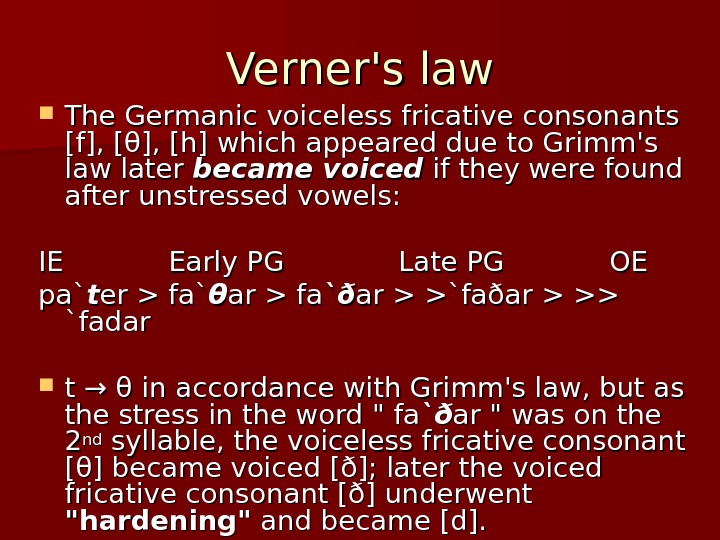
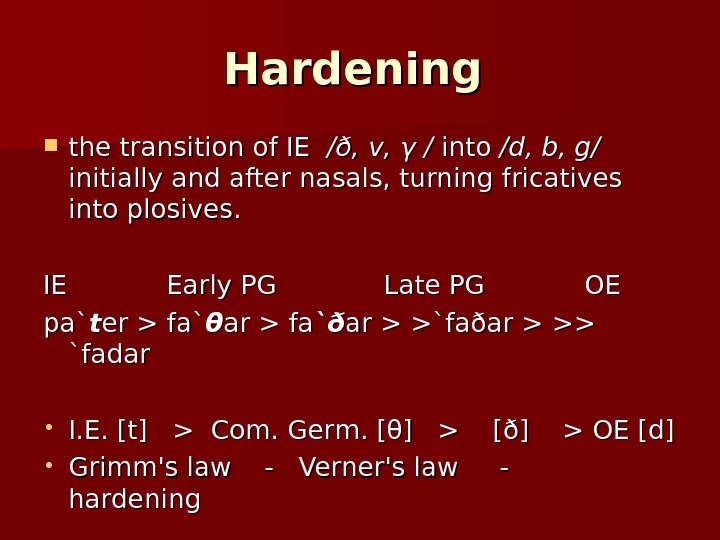
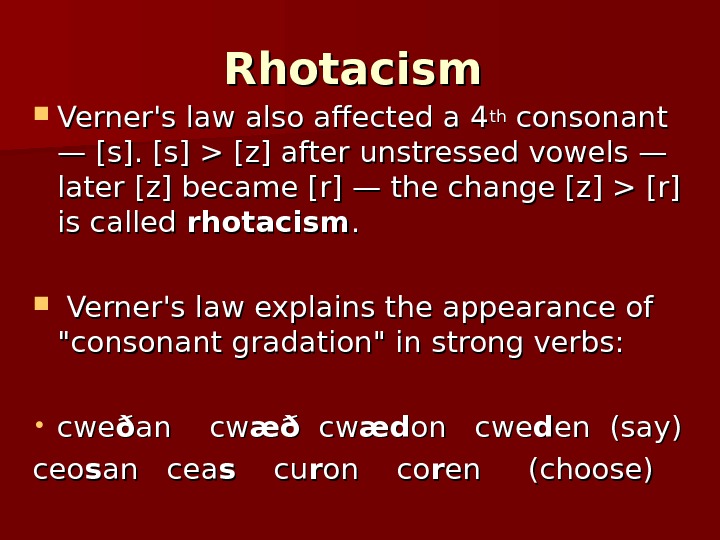

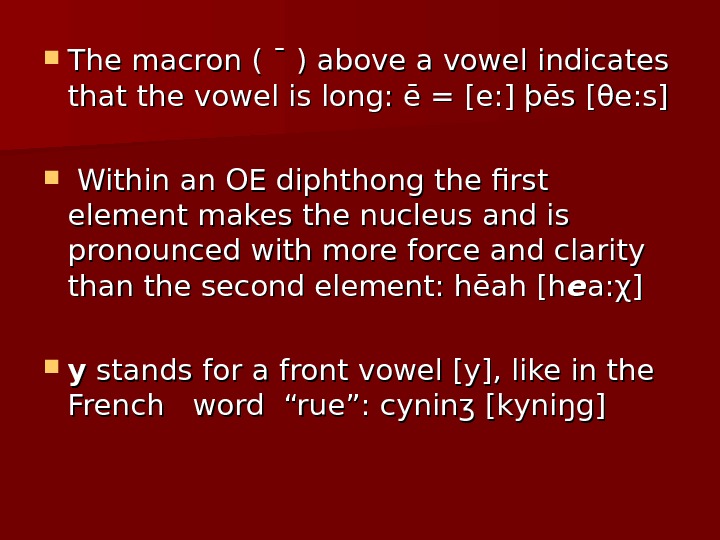
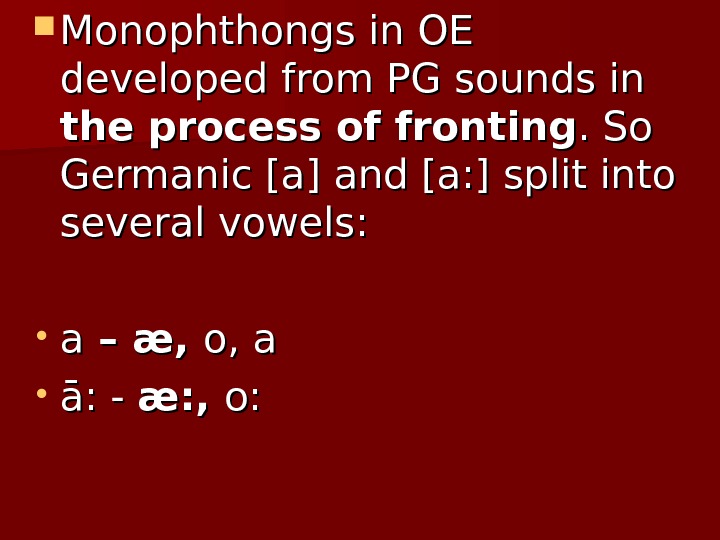
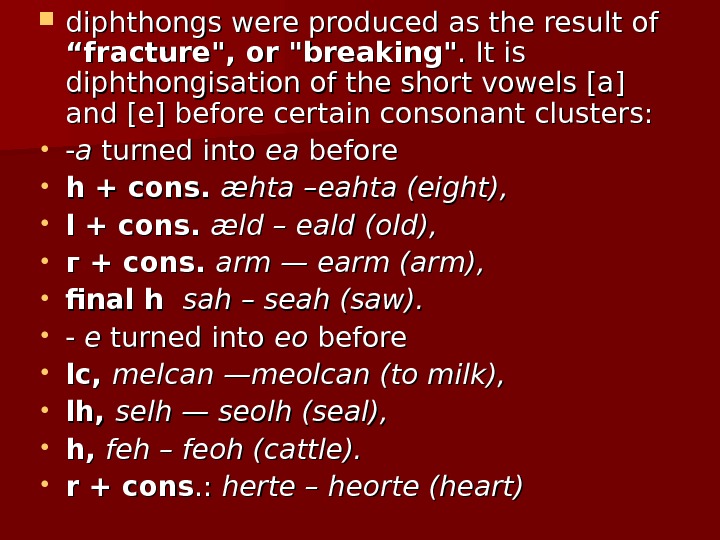
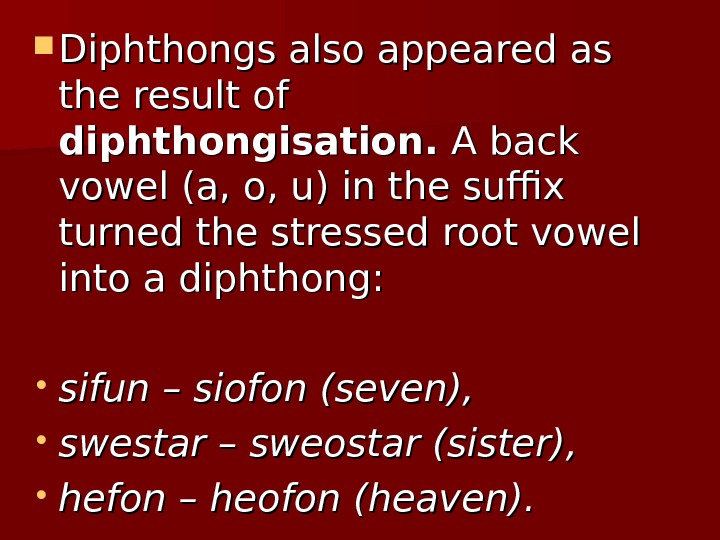
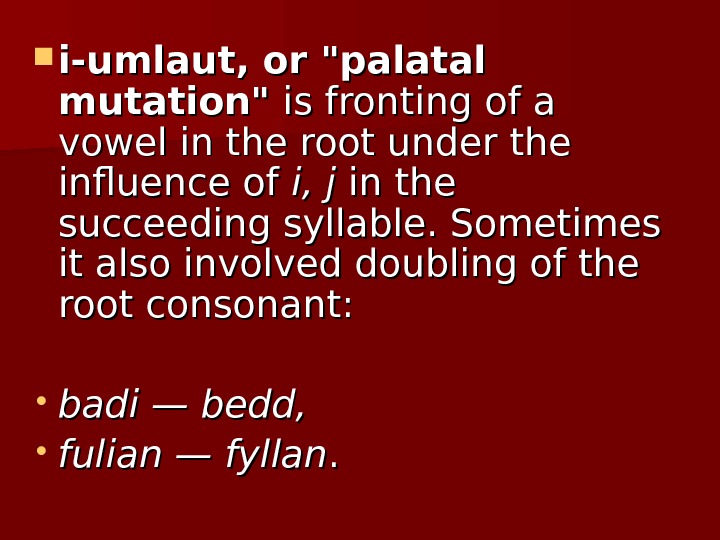
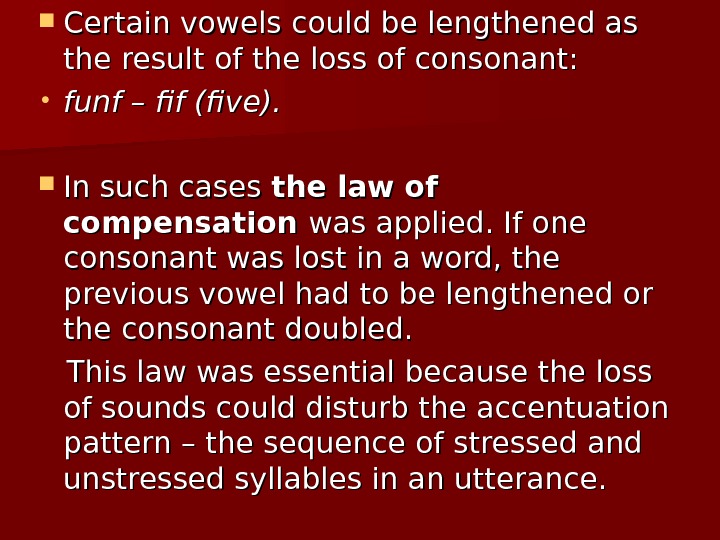
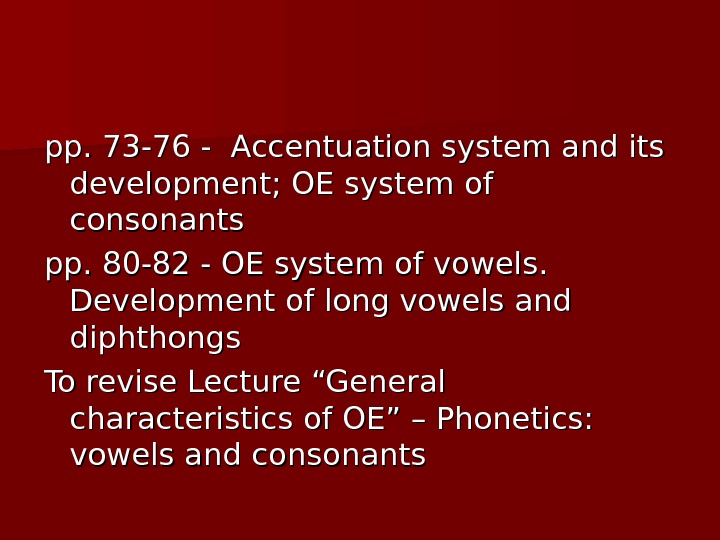
- Размер: 125.5 Кб
- Количество слайдов: 28
Описание презентации OLD ENGLISH PHONETICS Accentuation system по слайдам
 OLD ENGLISH PHONETICS
OLD ENGLISH PHONETICS
 Accentuation system dynamic stress fixed on the first root syllable: • agāne (gone); • ʒesēon (see); • ʒaderian (gather)
Accentuation system dynamic stress fixed on the first root syllable: • agāne (gone); • ʒesēon (see); • ʒaderian (gather)
 Polysyllabic words and compounds — two stresses: • chief (on the first component) • secondary. Grammatical endings were unstressed: • hlaforde – hlaford (lord); • cyninʒe — cyninʒ (king); • æþelinʒʒa – æþelinʒ (nobleman)
Polysyllabic words and compounds — two stresses: • chief (on the first component) • secondary. Grammatical endings were unstressed: • hlaforde – hlaford (lord); • cyninʒe — cyninʒ (king); • æþelinʒʒa – æþelinʒ (nobleman)
 Verb prefixes were unaccented: • a-‘risan (arise), • mis-‘faran (go astray). In adjectives and nouns the stress shifted onto the prefix: • ‘or-eald (very old), • ‘to-weard (towards), • ‘mis-dæd (misdeed).
Verb prefixes were unaccented: • a-‘risan (arise), • mis-‘faran (go astray). In adjectives and nouns the stress shifted onto the prefix: • ‘or-eald (very old), • ‘to-weard (towards), • ‘mis-dæd (misdeed).
 In words derived from the same root, word stress distinguished nouns from verbs: • ‘and-swaru (noun) – and-‘swarian (verb) – answer; • ‘‘ onʒin (noun) — on’ʒinnan (verb) – beginning, begin.
In words derived from the same root, word stress distinguished nouns from verbs: • ‘and-swaru (noun) – and-‘swarian (verb) – answer; • ‘‘ onʒin (noun) — on’ʒinnan (verb) – beginning, begin.
 OE system of consonants 14 consonants: • p, b, m, f, t, d, n, s, r, I, þ (ð), c, ʒ, h some of the modern sounds were non-existent: • [ʃ], [ʒ], [ʧ], [ʤ]
OE system of consonants 14 consonants: • p, b, m, f, t, d, n, s, r, I, þ (ð), c, ʒ, h some of the modern sounds were non-existent: • [ʃ], [ʒ], [ʧ], [ʤ]
 Consonants Labial, labiodental Dental Palatal Velar Noise plosives voiceless p p: t t: k’ k’: k k: voiced b b: d d: g’: g g: fricative s voiceless f f: θ θ: s s: x’ x’: x x: h voiced v ð z γ’ γ Sonorants m m: w n n: r l j ŋ
Consonants Labial, labiodental Dental Palatal Velar Noise plosives voiceless p p: t t: k’ k’: k k: voiced b b: d d: g’: g g: fricative s voiceless f f: θ θ: s s: x’ x’: x x: h voiced v ð z γ’ γ Sonorants m m: w n n: r l j ŋ
 All the consonants fell into • soso norants (m, w, n, r, l, ŋ, j) and • noise consonants. Noise consonants were subdivided into • voiced plosives (b, d, g) • voiceless plosives (p, t, k) • voiced fricatives (v, ð, z, γ )) • voiceless fricatives (f, θ, h, x ). Sometimes voicing was the only point of difference between allophones — — variants of a phoneme depending on the phonetic surrounding and serving to distinguish between words.
All the consonants fell into • soso norants (m, w, n, r, l, ŋ, j) and • noise consonants. Noise consonants were subdivided into • voiced plosives (b, d, g) • voiceless plosives (p, t, k) • voiced fricatives (v, ð, z, γ )) • voiceless fricatives (f, θ, h, x ). Sometimes voicing was the only point of difference between allophones — — variants of a phoneme depending on the phonetic surrounding and serving to distinguish between words.
 Palatalised sounds (k’, g’, x’, γ ‘ )‘ ) — not typical of Mn. E. Short and long consonants: • /f, s, n/ • /p, g / were doubled in spelling to indicate length — part-time, big game. Difference in length was semantic (and distinguished in the intervocal position) : • hopian /p/ — to hope • hoppian /p: / — to hop • cwelan /l/ – to die • cwellan /l: / — to kill • mete /t/ — to meet • mette / t: / — met
Palatalised sounds (k’, g’, x’, γ ‘ )‘ ) — not typical of Mn. E. Short and long consonants: • /f, s, n/ • /p, g / were doubled in spelling to indicate length — part-time, big game. Difference in length was semantic (and distinguished in the intervocal position) : • hopian /p/ — to hope • hoppian /p: / — to hop • cwelan /l/ – to die • cwellan /l: / — to kill • mete /t/ — to meet • mette / t: / — met
 In OE consonants were subjected to the processes of: — voicing — devoicing; — doubling; — metathesis; — Grimm’s law; — Verner’s law; — hardening; — rhotacism.
In OE consonants were subjected to the processes of: — voicing — devoicing; — doubling; — metathesis; — Grimm’s law; — Verner’s law; — hardening; — rhotacism.
![Voicing - devoicing f, þ, ð, s are voiced in intervocal position: • hlaf [f] Voicing - devoicing f, þ, ð, s are voiced in intervocal position: • hlaf [f]](/docs//4_old_english_phonetics_images/4_old_english_phonetics_10.jpg) Voicing — devoicing f, þ, ð, s are voiced in intervocal position: • hlaf [f] (bread) – hlaford [v] (breadkeeper) • ʒos [s] — ʒoses [z] (goose, Nom. sing. – Gen. sing. ) • toð [θ] — toðes [ð] (tooth, Norn. sing. — Gen. sing. )
Voicing — devoicing f, þ, ð, s are voiced in intervocal position: • hlaf [f] (bread) – hlaford [v] (breadkeeper) • ʒos [s] — ʒoses [z] (goose, Nom. sing. – Gen. sing. ) • toð [θ] — toðes [ð] (tooth, Norn. sing. — Gen. sing. )
![Palatal – velar articulation The phoneme denoted by the letter с с —— palatal [к'] (before Palatal – velar articulation The phoneme denoted by the letter с с —— palatal [к'] (before](/docs//4_old_english_phonetics_images/4_old_english_phonetics_11.jpg) Palatal – velar articulation The phoneme denoted by the letter с с —— palatal [к’] (before the vowel ii ): • cild (child) , • scip (ship) velar [k] (in the majority of cases): • can (can), • climban (to climb).
Palatal – velar articulation The phoneme denoted by the letter с с —— palatal [к’] (before the vowel ii ): • cild (child) , • scip (ship) velar [k] (in the majority of cases): • can (can), • climban (to climb).
![phoneme denoted by the letter ʒ: ʒ: voiced velar plosive [g] at the beginning of the phoneme denoted by the letter ʒ: ʒ: voiced velar plosive [g] at the beginning of the](/docs//4_old_english_phonetics_images/4_old_english_phonetics_12.jpg) phoneme denoted by the letter ʒ: ʒ: voiced velar plosive [g] at the beginning of the word before back vowels or consonants or in the middle of the word after nn : : • ʒod (good), • ʒretan (to greet, to address), • ʒаnʒаn (to go) voiced velar fricative [γ] in the middle of the word between back vowels: • daʒas (days) voice palatal fricative [j] before and after front vowels: • dæʒ (day), • ʒeаr (year)
phoneme denoted by the letter ʒ: ʒ: voiced velar plosive [g] at the beginning of the word before back vowels or consonants or in the middle of the word after nn : : • ʒod (good), • ʒretan (to greet, to address), • ʒаnʒаn (to go) voiced velar fricative [γ] in the middle of the word between back vowels: • daʒas (days) voice palatal fricative [j] before and after front vowels: • dæʒ (day), • ʒeаr (year)
 Doubling prolonging the consonant sound (except for /r/) to indicate long vowels. • badi – bedd (bed); • fulian –fyllan (become foul).
Doubling prolonging the consonant sound (except for /r/) to indicate long vowels. • badi – bedd (bed); • fulian –fyllan (become foul).
 Metathesis a phonetic change in which two sounds exchange their places: • brid — bird; • drit — dirt; • forst -frost; • grapsen — grasp; • moudle — mould.
Metathesis a phonetic change in which two sounds exchange their places: • brid — bird; • drit — dirt; • forst -frost; • grapsen — grasp; • moudle — mould.
![Grimm's law The voiceless plosive consonants [p], [t], [k] of non-Germanic Indo-European languages shifted in Germanic Grimm's law The voiceless plosive consonants [p], [t], [k] of non-Germanic Indo-European languages shifted in Germanic](/docs//4_old_english_phonetics_images/4_old_english_phonetics_15.jpg) Grimm’s law The voiceless plosive consonants [p], [t], [k] of non-Germanic Indo-European languages shifted in Germanic languages into the voiceless fricative consonants [f], [θ], [h]: • пена -fama (foam) • пять — fiv (five) • три — θrie (three) • ты — þu (thou) • кров — hrof (roof) • kardia — heorte (heart) • octo — eahta (eight)
Grimm’s law The voiceless plosive consonants [p], [t], [k] of non-Germanic Indo-European languages shifted in Germanic languages into the voiceless fricative consonants [f], [θ], [h]: • пена -fama (foam) • пять — fiv (five) • три — θrie (three) • ты — þu (thou) • кров — hrof (roof) • kardia — heorte (heart) • octo — eahta (eight)
 Verner’s law there are certain words in Germanic languages where instead of the expected voiceless fricative consonants we find voiced plosive consonants. These «exceptions» to the rule are a result of the further development of the fricative consonants which appeared in Germanic languages after the first consonant shift.
Verner’s law there are certain words in Germanic languages where instead of the expected voiceless fricative consonants we find voiced plosive consonants. These «exceptions» to the rule are a result of the further development of the fricative consonants which appeared in Germanic languages after the first consonant shift.
![Verner's law The Germanic voiceless fricative consonants [f], [θ], [h] which appeared due to Grimm's law Verner's law The Germanic voiceless fricative consonants [f], [θ], [h] which appeared due to Grimm's law](/docs//4_old_english_phonetics_images/4_old_english_phonetics_17.jpg) Verner’s law The Germanic voiceless fricative consonants [f], [θ], [h] which appeared due to Grimm’s law later became voiced if they were found after unstressed vowels: IE Early PG Late PG OE pa`pa` tt er > fa` θθ ar > fa `ð`ð ar > >`faðar > >> `fadar t → θ in accordance with Grimm’s law, but as the stress in the word » fa `ð`ð ar » was on the 22 ndnd syllable, the voiceless fricative consonant [θ] became voiced [ð]; later the voiced fricative consonant [ð] underwent «hardening» and became [d].
Verner’s law The Germanic voiceless fricative consonants [f], [θ], [h] which appeared due to Grimm’s law later became voiced if they were found after unstressed vowels: IE Early PG Late PG OE pa`pa` tt er > fa` θθ ar > fa `ð`ð ar > >`faðar > >> `fadar t → θ in accordance with Grimm’s law, but as the stress in the word » fa `ð`ð ar » was on the 22 ndnd syllable, the voiceless fricative consonant [θ] became voiced [ð]; later the voiced fricative consonant [ð] underwent «hardening» and became [d].
 Hardening the transition of IE /ð, v, γ / into /d, b, g/ initially and after nasals, turning fricatives into plosives. IE Early PG Late PG OE pa`pa` tt er > fa` θθ ar > fa `ð`ð ar > >`faðar > >> `fadar • I. E. [t] > Com. Germ. [θ] > [ð] > OE [d] • Grimm’s law — Verner’s law — hardening
Hardening the transition of IE /ð, v, γ / into /d, b, g/ initially and after nasals, turning fricatives into plosives. IE Early PG Late PG OE pa`pa` tt er > fa` θθ ar > fa `ð`ð ar > >`faðar > >> `fadar • I. E. [t] > Com. Germ. [θ] > [ð] > OE [d] • Grimm’s law — Verner’s law — hardening
![Rhotacism Verner's law also affected a 4 thth consonant — [s] [z] after unstressed vowels Rhotacism Verner's law also affected a 4 thth consonant — [s] [z] after unstressed vowels](/docs//4_old_english_phonetics_images/4_old_english_phonetics_19.jpg) Rhotacism Verner’s law also affected a 4 thth consonant — [s] > [z] after unstressed vowels — later [z] became [r] — the change [z] > [r] is called rhotacism. . Verner’s law explains the appearance of «consonant gradation» in strong verbs: • cwecwe ðð an cw æðæð cw cw ædæd on cwe dd en (say) ceoceo ss an cea ss cu rr on co rr en (choose)
Rhotacism Verner’s law also affected a 4 thth consonant — [s] > [z] after unstressed vowels — later [z] became [r] — the change [z] > [r] is called rhotacism. . Verner’s law explains the appearance of «consonant gradation» in strong verbs: • cwecwe ðð an cw æðæð cw cw ædæd on cwe dd en (say) ceoceo ss an cea ss cu rr on co rr en (choose)
 OE system of vowels a) The quantity and the quality of the vowel depended upon its position in the word. Under stress any vowel could be found, but in unstressed position there were no diphthongs or long monophthongs, but only short vowels. b) The length of the stressed vowels (monophthongs and diphthongs) was phonemic : • metan (to measure) — mētan (to meet) • pin (pin) — pīn (pain) • god (god) — gōd (good) c) There was an exact parallelism of long and short vowels: • Short: monophthongs — а о e u i æ у; diphthongs — ea eo • Long: monophthongs — ā ō ē ū ī æ ÿ; diphthongs — ē аа ē ē оо
OE system of vowels a) The quantity and the quality of the vowel depended upon its position in the word. Under stress any vowel could be found, but in unstressed position there were no diphthongs or long monophthongs, but only short vowels. b) The length of the stressed vowels (monophthongs and diphthongs) was phonemic : • metan (to measure) — mētan (to meet) • pin (pin) — pīn (pain) • god (god) — gōd (good) c) There was an exact parallelism of long and short vowels: • Short: monophthongs — а о e u i æ у; diphthongs — ea eo • Long: monophthongs — ā ō ē ū ī æ ÿ; diphthongs — ē аа ē ē оо
 The macron ( ¯ ) above a vowel indicates that the vowel is long: ē = [e: ] þēs [θe: s] Within an OE diphthong the first element makes the nucleus and is pronounced with more force and clarity than the second element: hēah [h ee a: χ] уу stands for a front vowel [y], like in the French word “rue”: сусу ninʒ [ [ kk уу niŋg ]]
The macron ( ¯ ) above a vowel indicates that the vowel is long: ē = [e: ] þēs [θe: s] Within an OE diphthong the first element makes the nucleus and is pronounced with more force and clarity than the second element: hēah [h ee a: χ] уу stands for a front vowel [y], like in the French word “rue”: сусу ninʒ [ [ kk уу niŋg ]]
![Monophthongs in OE developed from PG sounds in the process of fronting. So Germanic [a] Monophthongs in OE developed from PG sounds in the process of fronting. So Germanic [a]](/docs//4_old_english_phonetics_images/4_old_english_phonetics_22.jpg) Monophthongs in OE developed from PG sounds in the process of fronting. So Germanic [a] and [a: ] split into several vowels: • aa – æ, o, a • ā: — æ: , o: o:
Monophthongs in OE developed from PG sounds in the process of fronting. So Germanic [a] and [a: ] split into several vowels: • aa – æ, o, a • ā: — æ: , o: o:
 diphthongs were produced as the result of “fracture», or «breaking». It is diphthongisation of the short vowels [a] and [e] before certain consonant clusters: • — aa turned into eaea before • h + cons. æhta –eahta (eight), • l + cons. æld – eald (old), • г + cons. arm — earm (arm), • final h sah – seah (saw). • — — ee turned into eo eo before • lc, melcan —meolcan (to milk), • lh, selh — seolh (seal), • h, h, feh – feoh (cattle). • r + cons. : herte – heorte (heart)
diphthongs were produced as the result of “fracture», or «breaking». It is diphthongisation of the short vowels [a] and [e] before certain consonant clusters: • — aa turned into eaea before • h + cons. æhta –eahta (eight), • l + cons. æld – eald (old), • г + cons. arm — earm (arm), • final h sah – seah (saw). • — — ee turned into eo eo before • lc, melcan —meolcan (to milk), • lh, selh — seolh (seal), • h, h, feh – feoh (cattle). • r + cons. : herte – heorte (heart)
 Diphthongs also appeared as the result of diphthongisation. A back vowel (a, o, u) in the suffix turned the stressed root vowel into a diphthong: • sifun – siofon (seven), • swestar – sweostar (sister), • hefon – heofon (heaven).
Diphthongs also appeared as the result of diphthongisation. A back vowel (a, o, u) in the suffix turned the stressed root vowel into a diphthong: • sifun – siofon (seven), • swestar – sweostar (sister), • hefon – heofon (heaven).
 i-umlaut, or «palatal mutation» is fronting of a vowel in the root under the influence of i, j in the succeeding syllable. Sometimes it also involved doubling of the root consonant: • badi — bedd, • fulian — fyllan. .
i-umlaut, or «palatal mutation» is fronting of a vowel in the root under the influence of i, j in the succeeding syllable. Sometimes it also involved doubling of the root consonant: • badi — bedd, • fulian — fyllan. .
 Certain vowels could be lengthened as the result of the loss of consonant: • funf – fif (five). In such cases the law of compensation was applied. If one consonant was lost in a word, the previous vowel had to be lengthened or the consonant doubled. This law was essential because the loss of sounds could disturb the accentuation pattern – the sequence of stressed and unstressed syllables in an utterance.
Certain vowels could be lengthened as the result of the loss of consonant: • funf – fif (five). In such cases the law of compensation was applied. If one consonant was lost in a word, the previous vowel had to be lengthened or the consonant doubled. This law was essential because the loss of sounds could disturb the accentuation pattern – the sequence of stressed and unstressed syllables in an utterance.
 pp. 73 -76 — Accentuation system and its development; OE system of consonants pp. 80 -82 — OE system of vowels. Development of long vowels and diphthongs To revise Lecture “General characteristics of OE” – Phonetics: vowels and consonants
pp. 73 -76 — Accentuation system and its development; OE system of consonants pp. 80 -82 — OE system of vowels. Development of long vowels and diphthongs To revise Lecture “General characteristics of OE” – Phonetics: vowels and consonants

